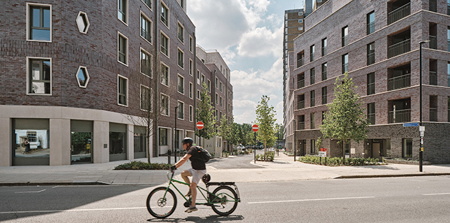

Agar Grove Phase 1C
Hawkins\Brown with Mae
: London Borough of Camden
Built in the mid-1960s, Agar Grove has always been a popular place to live, but by today’s design standards, the layout of the estate was inefficient, outdated and disconnected from the wider community. The masterplan, which transforms the estate into the largest Passivhaus development in the UK, provides 496 new homes in the London Borough of Camden, including affordable council homes, and temporary accommodation, as well as private sale homes to help fund the scheme. To date, 220 homes have been delivered over three phases, with Phase 1c, completed in 2024, delivered 125 residential units.The redevelopment prioritises energy performance to tackle fuel poverty. The new buildings of the Agar Grove estate are designed, built and certified to Passivhaus standards, reducing carbon emissions in use by reducing energy for heating and cooling to maintain comfortable temperatures in the building throughout the year by using fabric first Passivhaus standards of increased insulation levels, better air-tightness, minimised thermal bridging, high performance windows and a mechanical ventilation system with heat exchangers. Active frontages line the street-side elevations. Bedrooms are placed on the first floor or facing the court-yard gardens. Natural light and open spaces make the homes welcoming and spacious. There are residents’ growing areas alongside the secure communal gardens and playground. Planting is low maintenance, robust, provides seasonal interest and attracts wildlife. High-quality brick and GRC facade materials complement the Camden context. Informed by earlier phases, the thermal envelope of the larger building’s been simplified, reducing the area exposed to the elements.